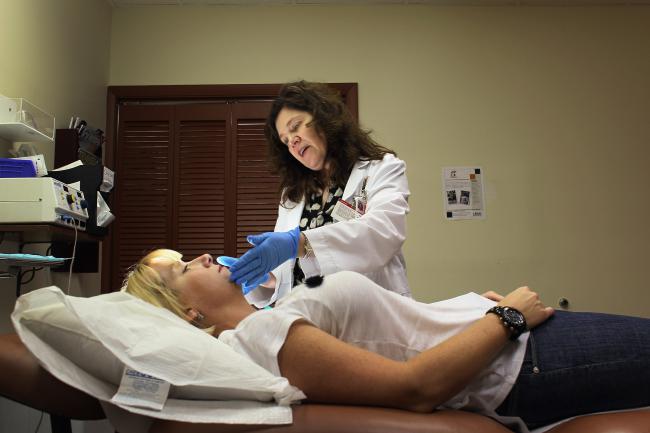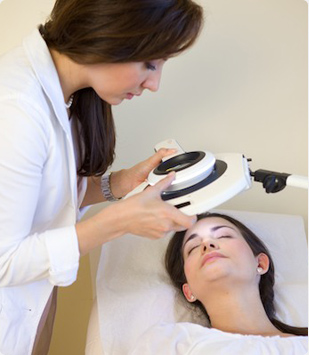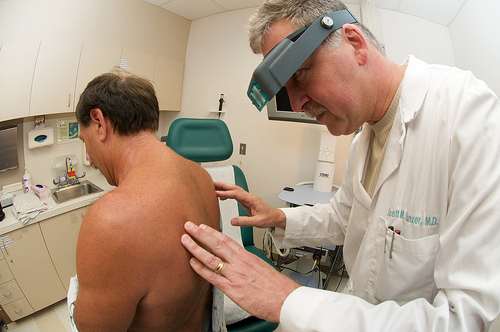Skin Cancer Screening Biography
Source (google.com.pk )Skin cancer is the most common malignancy in the white population worldwide. In Brazil, the National Cancer Institute (INCA) estimates that in 2010 there will be 119,780 and 5,930 new cases of non-melanoma skin cancer and melanoma, respectively. The aim of this study was to evaluate the use of a mobile unit in the diagnosis and treatment of skin cancer in several poor regions of Brazil.
Methods
The diagnosis of skin cancer was accomplished through active medical screening in the prevention Mobile Unit (MU) of Barretos Cancer Hospital (BCH). The study population consisted of patients examined in the MU between 2004 and 2007, and their suspicious lesions were subjected to histopathological evaluation. Data were collected prospectively from standardized forms and analyzed.
Results
During the screening, 17,857 consultations were carried out. A total of 2012 (11.2%) cases of skin cancer were diagnosed. The predominant histological type reported was basal cell carcinoma (n = 1,642 or 81.6%), followed by squamous cell carcinoma (n = 303 or 15.1%), Bowen's disease (n = 25 or 1.2%), malignant melanoma (n = 23 or 1.1%), basosquamous cell carcinoma (n = 3 or 0.1%), miscellaneous lesions (12 or 0.6%), and metatypical carcinoma (n = 4 or 0.2%). Only 0.6% of lesions were stage III. There were no stage IV non-melanoma skin lesions, as well as no melanomas stages III and IV, found.
Conclusions
It was observed that the MU can be a useful tool for early skin cancer diagnosis and treatment. This program probably is important, especially in developing countries with inadequate public health systems and social inequality.
Background
Skin cancer is the most common malignancy in the white population worldwide[1]. The 2 most common histopathological variants are basal cell carcinoma (BCC) and squamous cell carcinoma (SCC); despite their low mortality rates, these tumors can induce serious sequelae as a consequence of surgery[1]. The third most common skin cancer type, malignant melanoma, has a more aggressive behavior and consequently a poorer prognosis; malignant melanoma accounts for approximately 75% of all deaths from skin cancer[2].
There is strong evidence to date that whole-body clinical skin examination reduces the incidence of thick melanoma and, consequently, screening would reduce melanoma mortality[3]. Melanoma thickness at presentation is significantly associated with educational level[4]. In Brazil, the National Cancer Institute (INCA) estimates that in 2010 there will be 119,780 and 5,930 new cases of non-melanoma skin cancer and melanoma, respectively, which corresponds to 25% of all cancers for that period. The median 5-year survival rate for patients with melanoma is estimated at 73% in developed countries; however, it is only 56% in developing countries[5], reflecting their delayed diagnosis. Although the mortality from non-melanoma skin cancer is very low[5], important deformations can be consequences of the treatment.
The Brazilian Ministry of Health encourages the Brazilian population to avoid the sun during some periods of the day and to carefully examine their skin[5]. Few studies have reported the use of a mobile unit in the primary prevention of skin cancer[6,7]. Therefore, we did not find evidence of the use of a mobile unit equipped with a surgical room for the treatment of skin lesions. The aim of this study was to evaluate the use of a mobile unit in the diagnosis and treatment of skin cancer in several regions of Brazil.
The diagnosis of skin cancer was accomplished through active medical search in the prevention Mobile Unit (MU) of Barretos Cancer Hospital (BCH). The study population consisted of 17,857 pre-selected patients with suspected cancer of the skin who were examined in the MU between 2004 and 2007 to confirm the diagnosis.
The trailer portion of the MU was adapted and equipped for clinical and surgical procedures. The design of the truckers' trailer accommodations and facilities was totally developed by a BCH group. The mobile unit team is composed of a clinical or surgical oncologist, a nurse, 3 nursing assistants, and a driver, and this team is able to daily perform 40 physical examinations of the skin (with surgery and cryotherapy). In this study, we used the MU only for skin cancer prevention, diagnosis, and treatment. The MU is intended to travel to small cities and rural areas in several States of Brazil, including the Amazonas region. The MU visit is normally preceded by a phone call from a health care professional from the Department of Prevention of BCH; this individual makes the first contact with local authorities of the cities to be visited and plans the training of nurses and social assistants from these cities in the BCH. These local nurses are trained all day to identify suspicious lesions for skin cancer by the nurses and a physician from Barretos Cancer Hospital with experience in skin cancer screening. Specific conferences are offered in order to exemplify the different types of the more frequent skin lesions, and didactic materials (e.g., images CD, banners, leaflets and brochures) are given to support the educational training. These nurses are also responsible for speaking with the clinicians in these cities to convince them about the importance of their participation in the prevention activities and also for closely assisting the nurses' triage. In addition, they are encouraged to principally invite the underprivileged people that live in the suburbs or in rural areas and to inform them that all of the procedures related to the cancer prevention and treatment are free of charge.
Skin Cancer Screening Skin Cancer Pictures Moles Symptoms Sings On Face Spots On Nose Photos Types Pics Wallpapers Pics

Skin Cancer Screening Skin Cancer Pictures Moles Symptoms Sings On Face Spots On Nose Photos Types Pics Wallpapers Pics

Skin Cancer Screening Skin Cancer Pictures Moles Symptoms Sings On Face Spots On Nose Photos Types Pics Wallpapers Pics

Skin Cancer Screening Skin Cancer Pictures Moles Symptoms Sings On Face Spots On Nose Photos Types Pics Wallpapers Pics

Skin Cancer Screening Skin Cancer Pictures Moles Symptoms Sings On Face Spots On Nose Photos Types Pics Wallpapers Pics

Skin Cancer Screening Skin Cancer Pictures Moles Symptoms Sings On Face Spots On Nose Photos Types Pics Wallpapers Pics

Skin Cancer Screening Skin Cancer Pictures Moles Symptoms Sings On Face Spots On Nose Photos Types Pics Wallpapers Pics

Skin Cancer Screening Skin Cancer Pictures Moles Symptoms Sings On Face Spots On Nose Photos Types Pics Wallpapers Pics

Skin Cancer Screening Skin Cancer Pictures Moles Symptoms Sings On Face Spots On Nose Photos Types Pics Wallpapers Pics

Skin Cancer Screening Skin Cancer Pictures Moles Symptoms Sings On Face Spots On Nose Photos Types Pics Wallpapers Pics

No comments:
Post a Comment